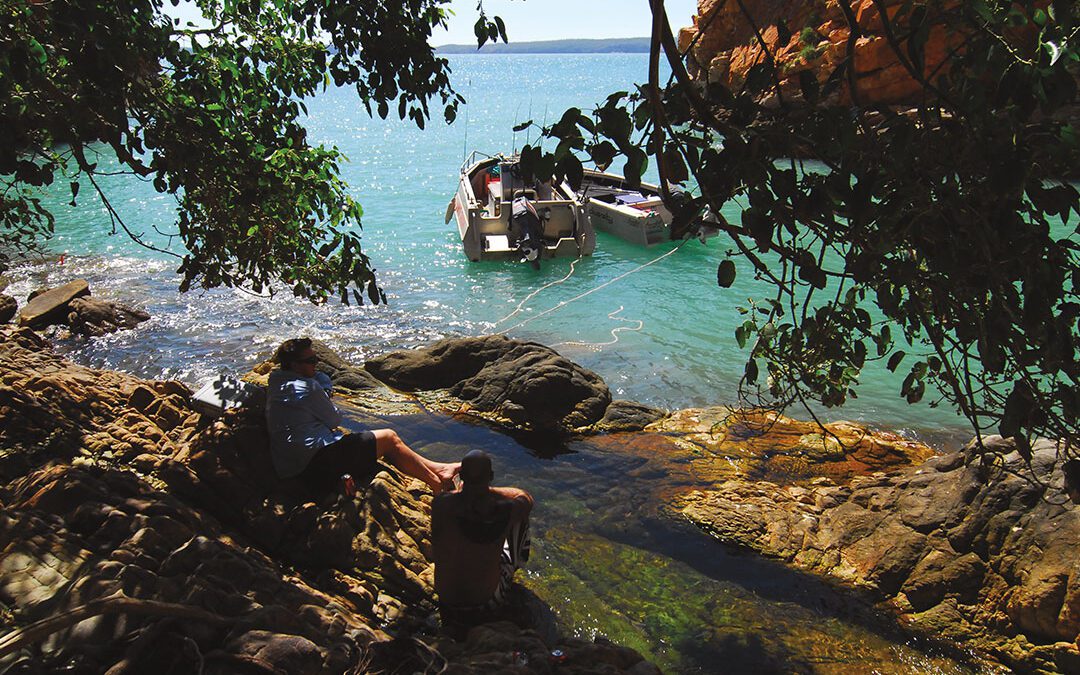Turquoise water surged over a partially submerged reef where the churning current pushed thousands of baitfish over the atoll. Awaiting the baitfish were scores of giant trevally, dozens of queenfish and a few reef sharks, none of which had ever seen a lure.
This reef and hundreds of others like it can be found roughly 150 miles northeast of Broome, Australia. The reefs surround a pair of sandy islets, called the Adeles, where the sheer numbers and varieties of sportfish are astounding. But there’s a catch. Getting to the Adeles from the U.S. is a long and expensive proposition.
Last May I journeyed to this remote region of the Indian Ocean in an attempt to mark off the last two species on my bucket list: giant trevally, often referred to as GT, and barramundi. Three previous trips for these fish, two to Palau and one to Australia, had been unsuccessful.
Barramundi is an Aboriginal word meaning “large-scaled river fish.” They sport a long body with a large upper jaw that extends behind the eye. Barramundi are found in both salt and freshwater and are considered by many to be Australia’s iconic sportfish. They are efficient predators, attacking from hiding spots in mangrove roots or submerged brushpiles. The world record tipped the scales at just over 38 pounds, but most fish caught by anglers weigh from 10 to 30 pounds.
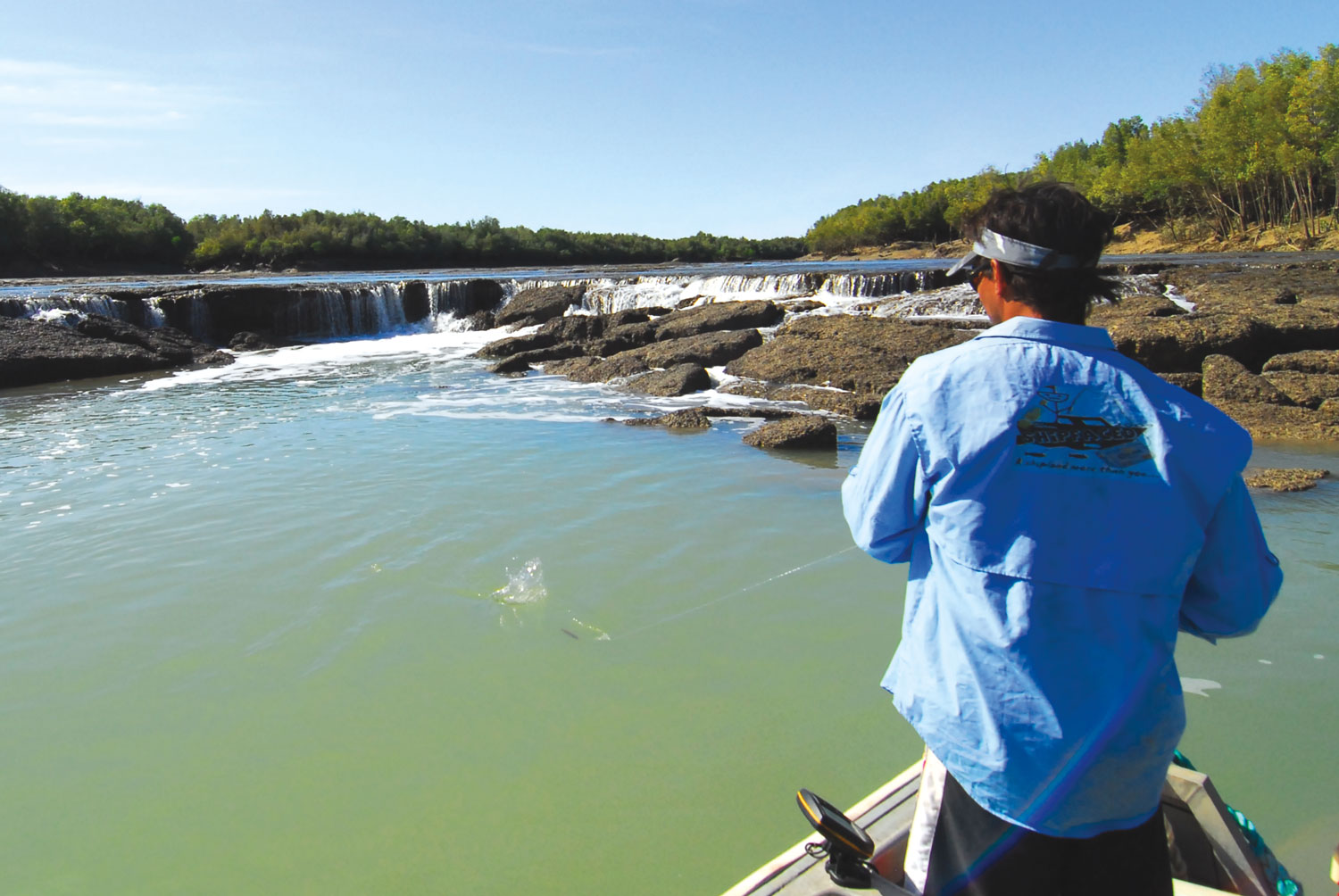
Although GTs are distributed throughout the Indian and Pacific oceans, they seldom occur in large numbers. The world record weighed 135 pounds, but the fish seldom reach even half that size. Given their scarcity and legendary fighting ability, the giant trevally is one of the most highly sought-after prizes of all.
You can imagine my excitement when I heard that both species abound near Broome. I began calling the handful of skippers working out of the city and soon learned that Sentosa Charters, operated by Cameron Birch, offered long-range trips that promised excellent catches of trevally and barramundi.
Birch said we would be exploring the area around the Adele Islands, which are offshore from a wilderness tract of Western Australia known simply as The Kimberly. He had never been there; for that matter, neither had many others. Still, Birch was convinced the area’s waters would be thick with GTs. His deckhand, who has Aboriginal roots and was raised in The Kimberly, swore that its mainland rivers were full of barras. (The Aussies love to shorten any word they can. A barramundi becomes a barra, a utility vehicle is a ute and chewing gum is a chewie.)
My trip there was an adventure in itself. After an all-night flight from Los Angeles to Sydney, I caught another plane to Perth followed by a three-hour air journey to Broome. As I flew over the vast expanse of terrain between Sydney and Broome, the parched land below appeared to stretch on forever.
To give a bit of perspective: Consider that Australia is large enough to contain Texas four times over. The state of Western Australia has more than 7,800 miles of coastline and the nearest decent-sized town to Broome is more than 1,000 miles away. Perched at the edge of the continent between the vast outback and the Indian Ocean, Broome (population 15,000) is the ideal jumping-off point for a once-in-a-lifetime angling adventure.
Birch had assembled a crew of expert anglers to share in our expedition. Our group consisted of Chris Nisbet, Broome’s most senior billfish captain; Tony Vuletic, an avid angler from Perth; and Williamson, a 30-something native of the village of Derby, which is the nearest habitation to the Adele Islands.
We left Broome in late afternoon on Birch’s 60-foot boat, The Equalizer, with two smaller tenders in tow and arrived at the Adele Islands just after daybreak. Our first impression was not positive. The Adeles are nothing more than a pair of sand islands barely high enough to jut above the water. But surrounding the Adeles are hundreds of square miles of brightly colored reefs, sandbars and channels, all covered with improbably clear turquoise water.
We were too eager to fish to waste time eating breakfast. Birch and I took the larger of the two tenders, while the others climbed into the smaller boat. We gingerly picked our way through the maze of coral reefs surrounding the islands, and eventually came upon a white coral reef that Birch thought might be productive.
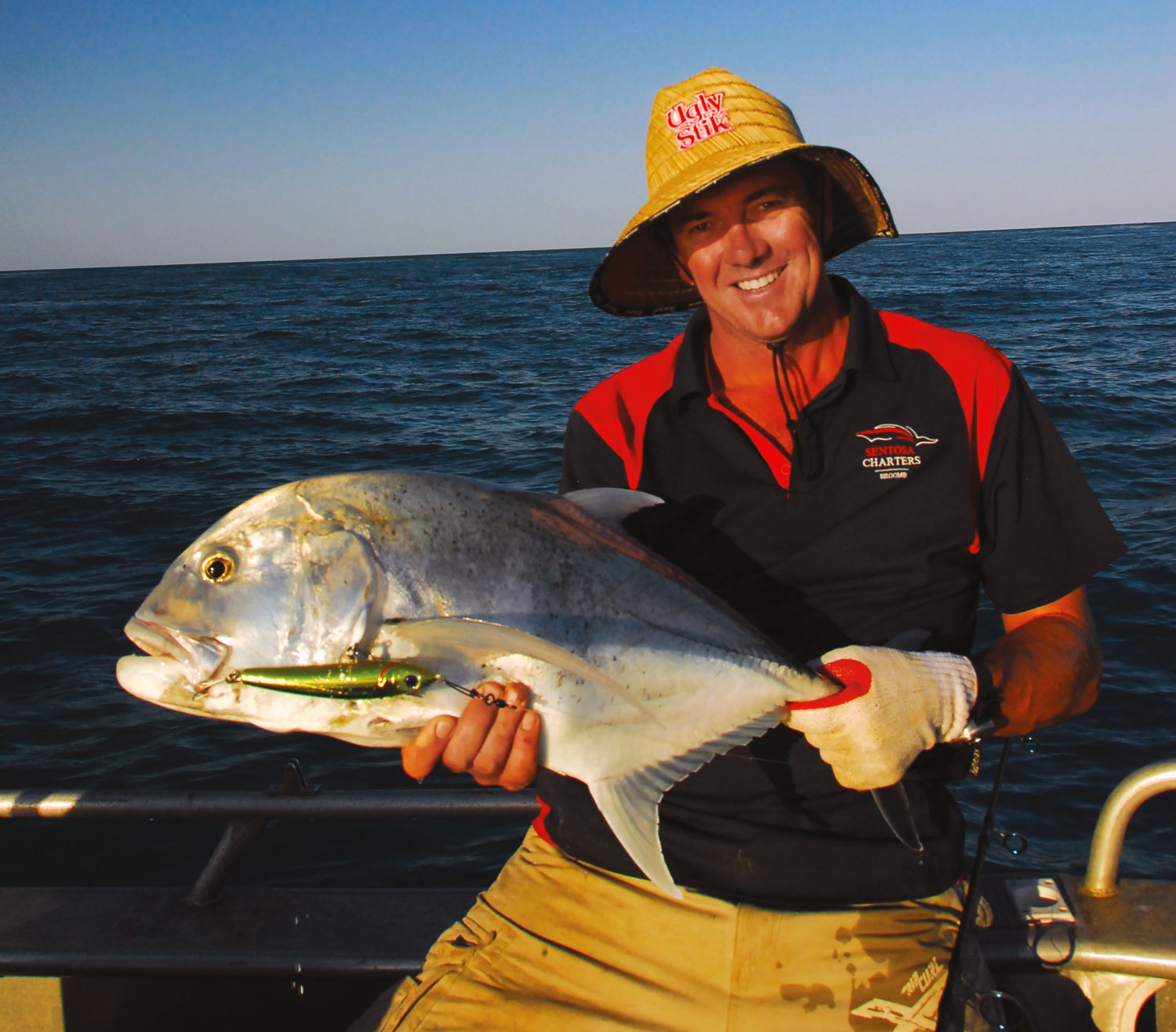
Our goal was to hook a GT. We began casting huge seven-inch poppers and retrieving them as fast as possible, while occasionally jerking to create big roostertails and popping sounds. We worked the entire reef with no action. A radio check with the other anglers revealed they, too, had found nothing.
Birch never lost faith. He was certain that as the tide went out, we would be able to see the best-looking structure. I was a bit skeptical, but then I had no idea as to the extent of the tide swings. (I later learned that 28-foot tides are not uncommon in The Kimberly.)
As the tide dropped, we saw dozens of likely looking reefs. One had a hook at one end not unlike the Nike swoosh. We motored into the curve of the swoosh and began casting toward a current seam formed by the tide pouring over the reef.
Birch hooked something big on his first cast. As I looked over to see what he had, the water exploded beneath my popper. Birch hollered, “Well, there’s your first GT.”
I wasn’t sure what I’d hooked, but I knew it was strong. Line ripped off my oversized spinning reel at an alarming pace. Birch was having a better time of it with his fish. As it came to hand, we could see it was a decent-sized trevally.
Certain I was into my first GT, I played it carefully so not to lose it. But giant trevally will not yield to gentle pressure. Birch told me to tighten the drag and make him work. I did as told and slowly began to bring in the fish. When it neared the boat, Birch tailed my first-ever GT. To say I was ecstatic would be a serious understatement. Birch grabbed my camera and recorded a truly goofy grin.
By the time we were done documenting one of my long-held goals, the guys in the other boat arrived. For the next few hours the five of us caught GT and queenfish, a thin, silvery fish that fights hard and jumps often, almost at will. Whenever anyone hooked up, a mixed school of GTs and queenfish would follow their distressed brethren to the boat. Often, the following fish would strike the other anglers’ lures.
Once the tide rolled in, the flats disappeared and so did the fish. But by then we’d caught so many fish we were ready for a break, so we retreated to The Equalizer to plot our next move.
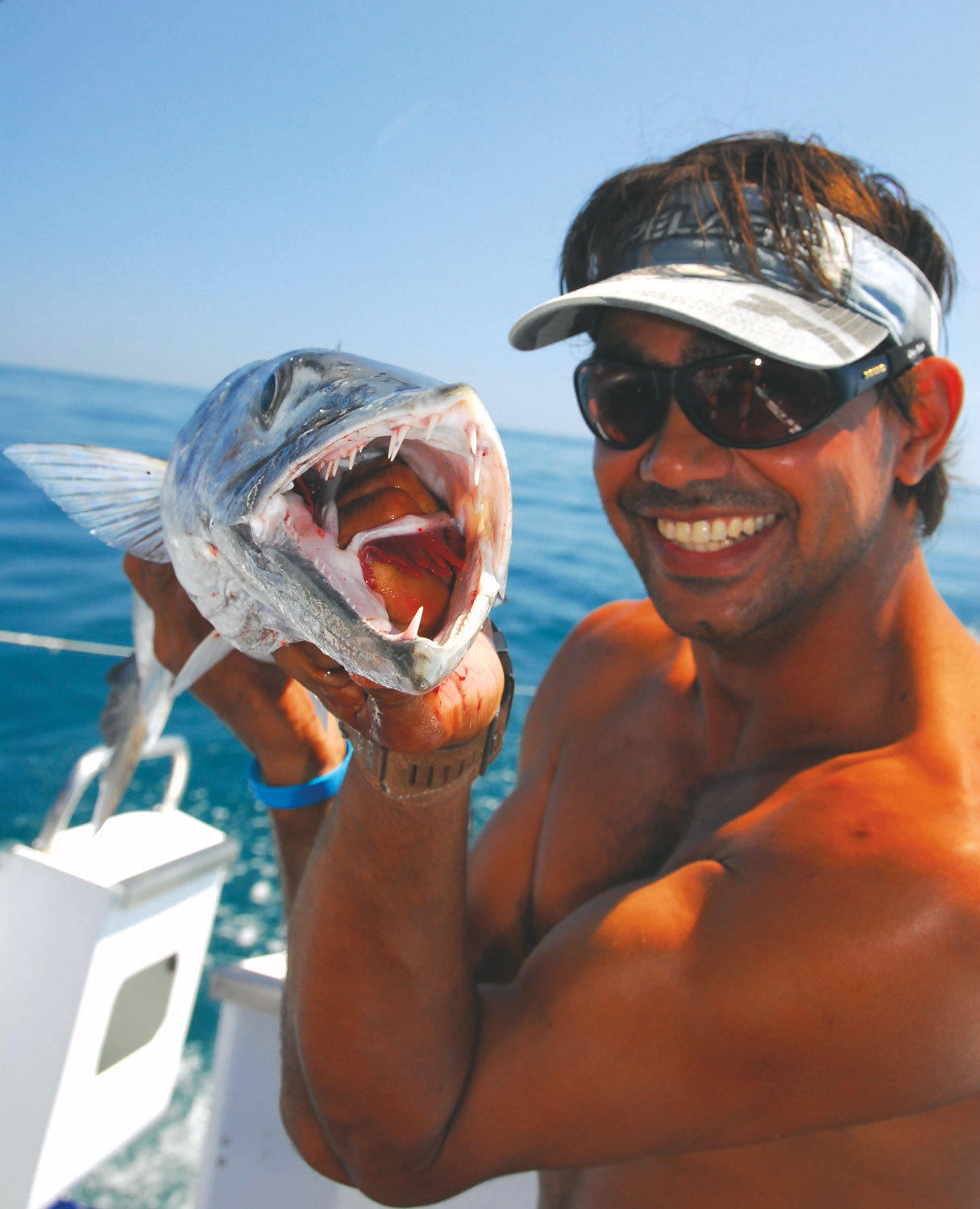
We decided to try for reef fish while awaiting the next low tide. We dropped cut baits to the bottom and we’re immediately hooked up. Before darkness came we caught nine species, including more GTs and queenfish, as well as a gold-barred snapper, fingermark perch, golden trevally, black trevally and several varieties of shark.
That evening the Aussies seemed determined to live up to their reputation as serious beer drinkers. It was great fun to listen to their conversations, laced with all their strange terms and quaint phrases. I learned that billies are billfish, small boats are tinnies, birds are women, sunnies are sunglasses and gob-smacked is surprised. Had one of them put those all of terms together, they might have said, “That bird needs to wear her sunnies when fishing for billies. If I she catches anything in that tinnie, I’ll be gob-smacked.”
The next morning Birch asked if I was ready to have a go at a barra. That question was easily answered. The night before, Williamson had regaled me with tales of big barra in mainland rivers and I was more than ready to meet my first one. But before we headed to the mainland, Williamson had a special treat for us.
We pulled anchor and motored toward the mainland, a seven-hour journey. Williamson directed us to a rocky headland where we dropped anchor. He told us to grab a few buckets, hammers and screwdrivers. We did as told and headed to shore in the tenders.
The beach was littered with boulders the size of a house and larger. Below the high-water mark Williamson pointed out tremendous numbers of large oysters. He pried out a six-inch specimen, shucked it open and slurped it down. Soon all five of us were enjoying the world’s freshest oysters. Aussie oysters are much larger than those found at home and are much firmer. We ate all we could and took several bucketfuls back to the boat for that evening’s barbie.
We then motored a few miles to the mouth of a long, narrow inlet. It was clear the tide was high as no beach was visible. Williamson kept referring to “the river,” but I saw no sign of it. But as the tide receded, the inlet was transformed into a surging current. The water continued to flow ever faster, disgorging millions of gallons into the sea, and as the tide dropped, steep muddy banks emerged.
When the tide was almost fully out, Williamson handed me a stout spinning outfit loaded with 25-pound-test braid. I thought the heavy line would be overkill for a fish I knew to average around 12 pounds, but assumed he knew what he was doing.
We pushed upstream against the slackening current. Grey mudbanks loomed higher than our heads, above water that was nearly the same color. Clumps of mangroves, some partially submerged, others protruding several feet above the surface, dotted the shoreline.
When we came to a large clump of mangroves, Williamson positioned our boat less than 15 feet from the tangled mass and told me to cast my diving plug as close to the vegetation as possible. I asked him if we wouldn’t spook the fish by coming so close to the mangroves.
“These are the toughest, most aggressive fish in the world,” he responded. “Our boat won’t bother them a bit. The only thing out here tougher than a barramundi is a saltwater crocodile.”
We had cast our plugs in and around the mangroves for perhaps three minutes before Williamson said, “Let’s go.”
We soon settled into a pattern of working each clump of mangroves for a minute or two, then moving on. Williamson explained that when barramundi are feeding, they’ll usually attack the first lure they see. After our fifth mangrove cluster, I was losing faith. I told myself that scratching one species off my bucket list was more than enough for this trip. But I kept casting. Then it happened. My plug was smashed with such fury it frightened me.
Williamson hollered, “You’ve got one. Keep the pressure on him. Keep him out of the mangroves.”
Now I understood why the heavy tackle. The barramundi repeatedly struggled to reach the safety of the tree roots, but each time I was able to drag him back into open water. He then did a series of somersaults, clearing the water by a good three feet. The jumps seemed to exhaust him as he then came to the net rather easily and Williamson quickly swept him up. I had my first barramundi!
At that point I was as happy as an angler can get. I couldn’t imagine how the trip could get any better – but it did. Mother Nature was about to put on a spectacular show.
Williamson and I landed five more barramundi before the tide slackened and began running back upriver. They all fought like berserkers and every one was a special thrill.
As the tide dropped I could see that the high-water mark was at least 20 feet above our heads. The tide ebbed for less than 15 minutes before changing direction and pushing back upstream. The ocean poured into the narrow valley so rapidly that a strong current was soon flowing in the opposite direction, inundating the mangroves, rocks and other landmarks as we watched. Williamson explained that the incoming tide would stir up so much mud that fishing would be impossible.
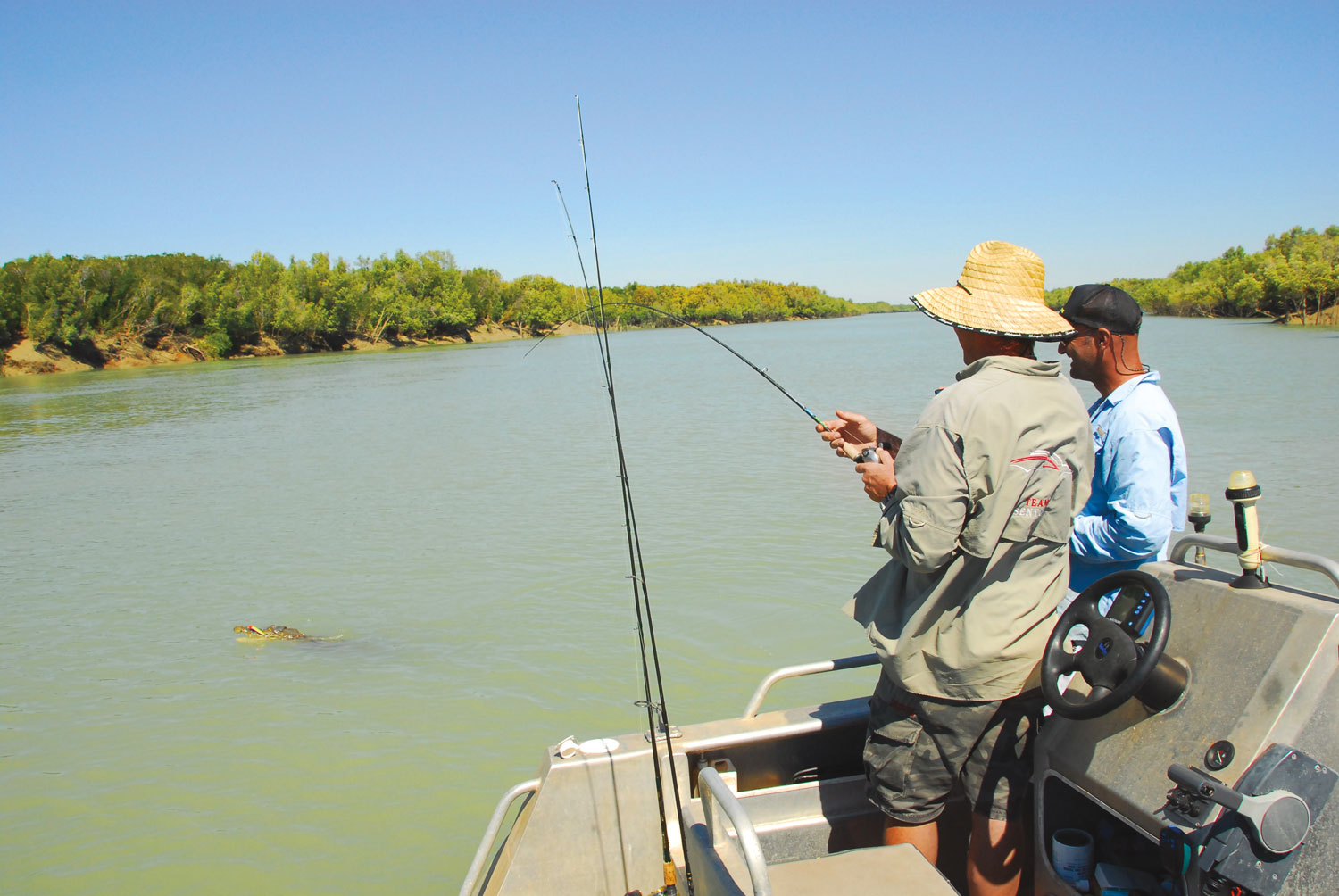
As we were leaving the river, we came upon our other anglers and I could see they had caught something big. When we drew near, we saw that they’d hooked a crocodile, an honest-to-God saltwater killing machine. It was a “small” one, perhaps eight feet in length. Australia’s saltwater crocs kill people every year, and this one didn’t seem at all happy.
Birch told us the croc appeared out of nowhere to inhale his plug. I assumed they would break the line and let the croc have the lure. But Birch said he really wanted his lure back and Williamson was more than willing to attempt the task. We helped him swing the croc around so Williamson could get a lasso around its snout. It was apparent he was worried, as well he should have been. He still bears scars from an earlier encounter with a pissed-off croc. After several unsuccessful attempts with the lasso, he was finally able to knock the lure loose with a paddle. At that point we all agreed it was time to call it a day.
That night we fired up the barbie on the back deck of The Equalizer. Our seafood feast included fresh oysters, mangrove snapper and barramundi, all washed down with fine Australian beer.
Sitting on the deck later that evening I became a bit melancholy when I considered that I had no more angling goals to strive for. Then I realized that I could always add another fish to my bucket list. I wonder how big those Nile perch can get? But that would have to be another time and another continent.

